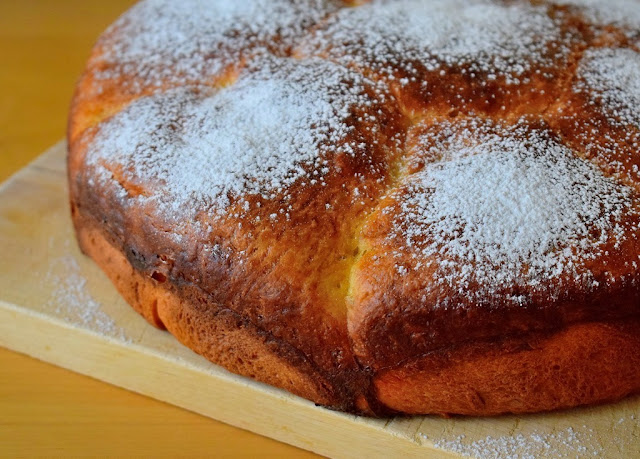 |
| Basic Brioche |
 |
| Basic Brioche |
This is one of those recipes that I have been longing to share with you.
During winter I often baked these sweet brioche buns from my childhood.
Although my brioche buns do not have an attractive appearance, I can
tell you without pretension that they were super delicious. The crumb was
perfect, very soft and light.
The ingredients are very simple - flour, sugar, eggs, milk and fresh
yeast. However, this old-fashioned method used by grandmothers is a slow
rise method. It takes approximately 4 hours for the first rise and another 2
hours for the second rise. It is worth the wait as you get the traditional
taste of brioche.
Usually I prepare the yeast dough in the evening and let it rise over
night completely, then I take the dough the next morning, shape it, leave it to
rise a bit more, cover with egg yolk and bake it. It’s easier this way and
works perfectly well!
Sometimes I varied the amount of butter and the flavours. The one in
the photo is richer in butter and has an orange flavour (I added the zest
of an orange to the dough and I used 150g of butter). A real treat, we
feasted.
Now it’s up to you to add your touch to this recipe - by adding dried
fruits, various nuts, crystallised fruit, spices (vanilla, cinnamon, ginger,
etc.) - however respect the steps of the recipe.
I have written the method and observations so you can succeed easily.
This brioche recipe is great to make at the weekend. Perfect for any brunch,
picnic or tea time.
 |
| Orange Brioche |
 |
| Orange Brioche |
 |
| Orange Brioche |
 |
| Orange Brioche |
 |
| Orange Brioche |
Ingredients:
300g plain flour, plus extra for dusting
2 eggs
70g sugar
140g butter, at room temperature (plus extra for greasing)
100 ml lukewarm full-fat milk
10g organic baker’s yeast
1/2 tsp salt
*Icing sugar (optional)
For
the egg wash:
1 egg yolk
2 tablespoons milk
Preparation:
1. Mix the yeast in the lukewarm milk.
2. In a bowl, make a well with the flour, sugar and salt. Add the yeast
milk and the beaten eggs. Mix well. Knead with a spatula or with the dough
hooks of an electric mixer, until a soft and smooth dough is obtained
3. Then, add the butter in pieces and knead again until dough becomes
elastic
(until the dough comes away from the container).
4. Then, cover the dough and let it rise to double its volume (for 4
hours) at room temperature.
5. When the time is up, remove the dough and place it on a well-floured
surface.
6. Knead again and then, divide the dough into 7 portions.
7. Roll the dough into a ball.
8. Arrange the dough on a well buttered cake mould and cover. Let it sit
for another 2 hours or until it is puffed up.
9. When dough has doubled in size, and before putting the mould in the
oven, brush the buns with egg wash (mix the egg yolk and the milk).
10. Bake in a preheated oven at 180ºC for about 20-30 minutes until
golden brown.
11. Remove, unmould, and leave
to cool on a wire rack.
Observations:
The amount of butter: the more the dough is rich in butter, the better
the brioche. By contrast, the dough will be much harder to shape because it is
very soft. As a rule, the weight of the butter is at least 50% of the weight of
the flour.
Avoid over-kneading once you incorporate the butter - diced and at room
temperature - stop as soon as the dough is smooth. If the dough is kneaded too
long, there is a risk of having a rubbery crumb.







































































